Episode #381: 3 Ways to Set Students Up for Summer Math Success | Your Summer Math Program
LISTEN NOW HERE…
WATCH NOW…
Summer learning loss in math is real—and it doesn’t affect all students equally. In this episode, we explore how the summer slide disproportionately impacts historically marginalized students and what teachers can do now to change that trajectory for mathematics. From family partnerships to incentive programs and low-effort prep ideas, we’ll walk you through practical ways to support continued learning for math over the summer months. Whether you’re a classroom teacher or a school leader, this episode will leave you with actionable takeaways that are simple to implement—and powerful in impact.
In this episode, you’ll discover:
- Understand which students are most at risk of math summer learning loss—and why.
- Learn how to involve families in meaningful and manageable summer math learning efforts.
- Explore low-prep math strategies teachers can implement before school ends to support retention.
- Discover ideas for incentivizing summer math engagement without overwhelming families or staff.
- Reflect on how equity can guide our summer math learning plans to better support all students
Attention District Math Leaders:
Not sure what matters most when designing math improvement plans? Take this assessment and get a free customized report: https://makemathmoments.com/grow/
Ready to design your math improvement plan with guidance, support and using structure? Learn how to follow our 4 stage process. https://growyourmathprogram.com
Looking to supplement your curriculum with problem based lessons and units? Make Math Moments Problem Based Lessons & Units
Be Our Next Podcast Guest!
Join as an Interview Guest or on a Mentoring Moment Call
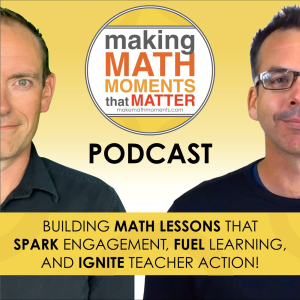
Apply to be a Featured Interview Guest
Book a Mentoring Moment Coaching Call
Are You an Official Math Moment Maker?
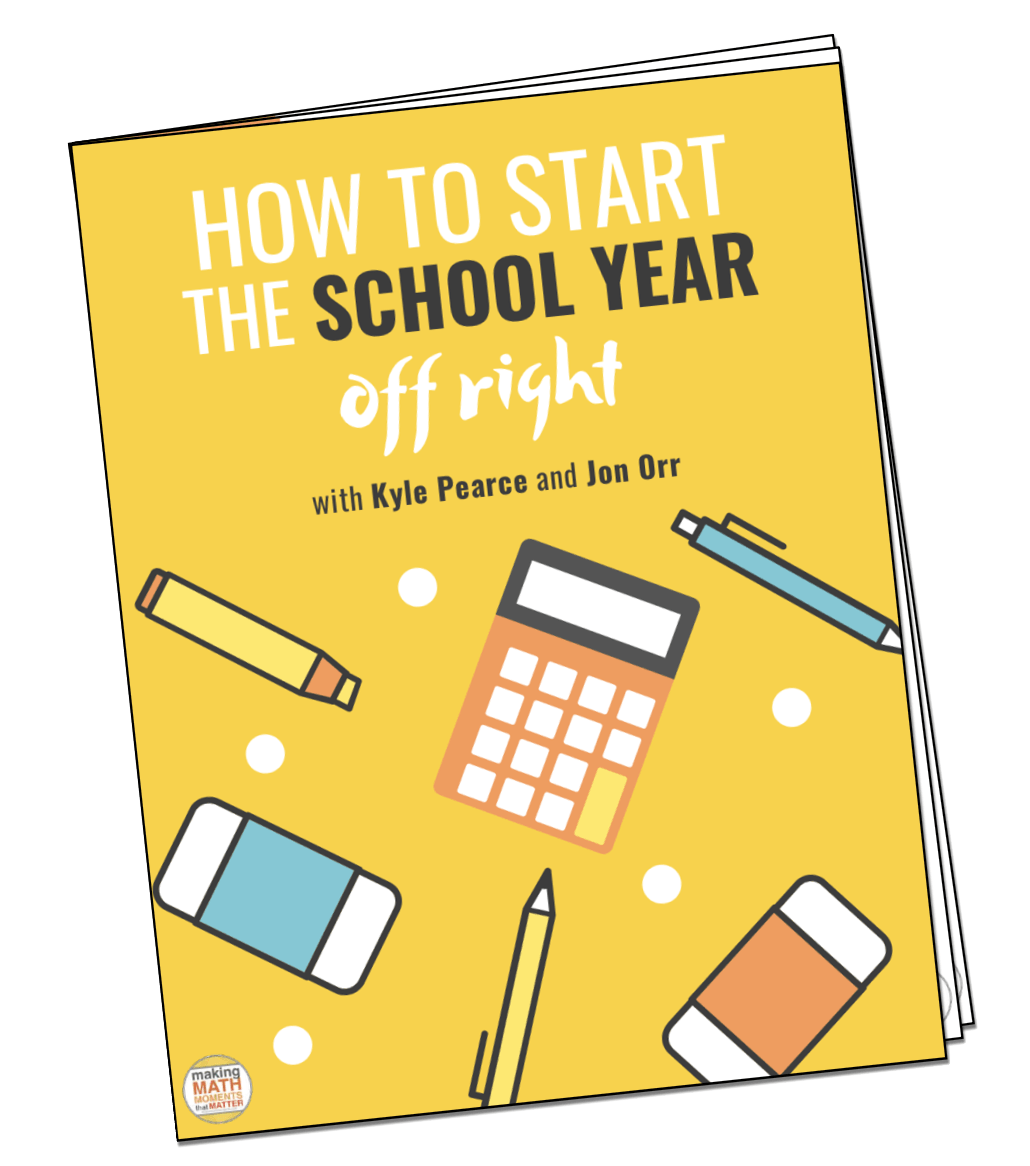
FULL TRANSCRIPT
Yvette Lehman: If you are listening to this episode when it goes live, is June here in Ontario. We are heading into summer break. I know many of the districts across the US are probably already on summer break. You may have been out for a couple of weeks already, but for here in Ontario, this topic today is completely top of mind because we are in the final stretch of the school year and students will be leaving for their extended holiday.
We recently had a conversation about the length of breaks, know, surprisingly they range. It’s like some districts have eight weeks. We talked to a district recently, John, I think they had almost 12 weeks off, you know, between the end of year and the start back up. And when I heard, well, when I heard about those 12 weeks, I was like, that does sound great. But then I thought, Hmm, like what’s the impact of a 12 week, right.
Jon Orr: That sounds great. Right, sounds great for me, sounds great for them.
Kyle Pearce: Yeah. Well, and we have like, we know we have some friends down under, you know, in Australia, New Zealand, for example, where their school year is a little bit different, where they do like shorter breaks, but throughout the year. And we know that the research suggests that that’s actually likely a better fit for probably everyone. I think we all as teachers, John used to call it the longest Sunday night ever was like the night before the first day of school. Like August is that.
Jon Orr: August, well, for us, because we didn’t start until after Labor Day. So when August hit, half your summer’s over and you’re like, is, August is the longest Sunday night ever.
Kyle Pearce: Yeah, well, and I think what makes this really relevant is, you know, this idea when you talk about that district with 12 weeks off, it’s it’s fairly extreme that that is a large chunk of time, whether you have eight weeks, whether you have 12 weeks, it’s a long chunk. And I think today, what we’re hoping to do is to dive into some ideas that we might be able to provide educators in order to empower their families to maybe cut back on some of that
you know, summer learning loss as they call it, right. And I think really all it is, is being away for so long. I always, I always used to say kids come back and it’s like they format their brains over summer. And you know, I once taught the same group of kids back to back. And when they came back, they were saying things like, you never taught us that or we never did that. And I’m like, we, I promise you we did, you know, and it wasn’t that long ago, but to them, it certainly is. So
Jon Orr: Yeah. Let’s dig in for sure. Let’s dig in for sure. I think you pointed out that there’s certain school systems in here in Ontario, they’re piloting different schools to kind of do this all year learning where they’re not taking, say, the two months off in the summer, the nine weeks off in the summertime. They’re taking a week off in, say, October, and then all of a sudden maybe have a longer holiday in December. And then you’re stretching out some of that same time period to make the
Kyle Pearce: We’re excited to dig into some of these ideas.
Jon Orr: equal kind of time off time on to hit your required number of days or hours in the classroom. But then, so that makes sense, say, that makes sense research wise about learning in particular, but I don’t know, what are your guys’ thoughts specifically, like before we get into the specifics about like what to do to say limit learning loss if we do have the nine to 12 weeks off, what are your thoughts on like saying, like the people that say like,
kids need a break from school. know, like, what do we do? Like, they need not only a break from school, they need a break just to like pull back and do this over thing over here, or they need to like experience these other pieces of life like in a different way. Like, there are people I think that argue that side of things. And before we say jump into the, let’s make sure that we keep learning going at some point in our families. How do we want to address that before jumping there?
Yvette Lehman: That’s a tough question. mean, I think that, yeah, it’s a great question. think that, mm-hmm. I think that we also know that concentrating the break to one part of the year creates long stretches throughout the rest of the year where we do get a lot of fatigue and we get disengagement. So, I mean, I haven’t done extensive research on the full year calendar and the advantages. I mean, I definitely believe they exist.
Jon Orr: Mm-hmm. That’s why I tossed it at you guys.
Kyle Pearce: That’s why he asked it and didn’t answer it.
Yvette Lehman: I guess what I will say though is having the summer off sounds ideal when you maybe have caregivers who are available for you and who are creating those summer experiences that we picture depicted in movies. But the reality is you might have two working parents. So you’re actually now in camp all summer anyway, which may or may not be, you know,
the ideal outcome for all students. Or, you know, we being privileged don’t understand maybe how challenging it could be in like the food insecurity of an extended nine week break for many families or the stress level for parents to be the full-time caregiver for children if they have, you know, they’re struggling with their own mental health. So again, I don’t know the full research on this.
If I could wave my magic wand, we would all go to a full year school year calendar with extended breaks throughout the year. I don’t know that we need nine weeks. I think three or four weeks would be amazing, but I would love, you know, a longer break in the fall or a longer break in the spring to break up those big stretches of continuous learning.
Kyle Pearce: You brought up some of the pieces that honestly, again, being privileged myself and that didn’t come to my mind as one of these reasons that this could be problematic, right? And in my mind, I was picturing just from a learning perspective that we get about eight weeks off here in Ontario, this part of Canada, and…
the eight weeks, it’s like the idea of it and being from the classroom, being from the education system, I think we enjoy it probably more than the kids necessarily enjoy it or need it in a way. It’s like this idea of having all this free time. But the reality is it’s actually not that helpful. Like summer gets old pretty fast. Like you get pretty used to it, you know? And I feel like those other breaks throughout the year could definitely be more beneficial.
especially when it comes to this learning loss piece. But then like you had said, Yvette, is like, what are we doing with our time throughout the summer? And what are the kids doing with their time throughout the summer? If it’s not intentional, if it’s not structured, it’s likely not going to lead to anything very helpful or meaningful for them. So.
I too believe that a full school year, even though I would be sad to see summer go, like a full big break in summer, I would be sad to see it go. The reality is I think it actually would be a better move. Again, hypothesis only, not data research tier, but based on what we know about how the brain works and having been there and knowing those stretches you were talking about, Yvette, if we could break up some of those longer stretches.
Kyle Pearce: you know, especially here in Canada, we don’t get like a Thanksgiving break like many school systems do. That can get like very long. And then the winter months as well can get very long, especially during, you know, end of January into February.
Jon Orr: Let’s transition then into like what can we do coming into the end of the year? like you said, Yvette, it’s June. We know there’s going to be an extended break here. We know that there, you know, the data is saying that extended breaks if we’re not, making active your—or maybe even just like conscious or unconscious efforts for numeracy and math, say, discussions at home or sometimes that can go—you know, they got that summer slide happening come back in September. What can we do as educators for students in our classrooms to minimize, say, that summer slide. We’re just having a moves.
Yvette Lehman: Here in Ontario, feel like, you know, report cards are typically written by the second week of June. And we tend to have these last two weeks where, you know, assessment and evaluation is complete. We’re trying to keep students engaged. They’re already one foot out the door. And I thought to myself, how could we leverage those two weeks to set up not only students, but families to establish almost like habits and routines that they could carry through the summer? So.
Could we start every morning with a numeracy game and introduce a different numeracy game every day and have a dedicated time where we’re going to play this low prep but high impact game with students every morning? But I love the idea too, and I learned this from my experience teaching and summer learning of inviting families into the classroom to play those games. Oftentimes families are welcomed into the school for an assembly or for some type of presentation where they’re passive.
where I would love in those last two weeks to open the doors during the day or even evening to offer an alternative for parents or caregivers who work to come in and learn some of these low prep, low material math games that would have a high impact for students over the summer. We recently talked about how that connection to like math is like a language and the more we use it, the more fluent we become and the more our brain is almost like primed to do that type of thinking.
So if we could establish routines or structures that parents could easily adopt, where they’re just dedicating 15, 20 minutes every day to some type of routine that’s going to keep students working on even just their fact fluency or their spatial reasoning throughout the summer, we could use those last two weeks of the school year to establish kind of that protocol or that routine.
Kyle Pearce: I love it. And even for let’s say parents that are or guardians that are maybe unable to attend, whether it’s during school, after school, or maybe maybe unwilling or, or, you know, doesn’t maybe value that opportunity just by the students themselves being able to participate in all of those games. It’s like, at least the students have that sort of in their back pocket. And I’m picturing in my mind is that, you know, if there’s a handful of these games that you are utilizing in the classroom, is there
you know, a little cheat sheet we can send home with the kids, right? So that they know, Hey, here’s kind of the rules, the basic rules of this game or whatever. See if anyone in your family wants to play with you. Maybe you bring it to, you know, the, uncle and aunt’s house or, know, the neighbor’s house or whatever it is that at least someone is armed with this information and you never know how far that can really go. And I think ultimately, you know, these are those last few weeks where
All school year, we talk about how time is so precious before standardized tests, before report cards, before, you know, not, you know, checking off the list, the standard lists. What better way than to not only have some fun, keep the kids engaged, but then also arm them and their family with some ideas that they can pull out when, hey, maybe they go camping for a weekend in the summertime or. You know, again, they spend the afternoon at grandma’s house and, you know, they’re looking for something fun to do. I love it.
Jon Orr: Yeah, no, me too. Me too. You know, and one of the things I remember that when I was, I think I was after my first year of teaching, I was like a summer camp counselor. And I remember I didn’t plan out what the summer camp events would be, but I remember receiving as the counselor, what our schedule was going to look like. And it was like a calendar. And then every day we had like on the actual calendar. imagine like you print out your, you know, a typical calendar.
you know, grid, and each day had like, you’re doing this, and then you’re doing this. And it was like this type of activity and this type of activity. And it was like mapped out. So it’s like, you’re not you’re doing the same thing on every day, but gave you ideas. And because I was the counselor gave me the schedule to follow. But that I remember just being excited to like, see what was what I could do or what we were going to do for the summer.
which was different than what we had been doing, you know, all year as in classrooms and seeing that and going like, let’s dive in, let’s, I’m excited to kind of tackle this agenda that gives us ideas to work on, which, you know, when I’m thinking about that and having like an activity calendar to send home to say, like, we could be doing this, we could be doing this, here’s a link to this, here’s a link to that. And it’s all of sudden, this like nice schedule, because I think parents like being maybe
you know, working throughout the summer, not having as much time, because I think families might be like, summer is very busy, but also we do need things to like fill slots and help us with that. So it’s like, what is the thing? Like, should we have like this schedule mapped out? Talk to us about, Yvette, have you done this in your class? Like, I know that this schedule is always like an exciting.
Yvette Lehman: Okay. Yes. I’m, I’m so excited. Sometimes it’s like you really tee me up for the right thing that I want to say right now. So two things. As a parent, I really need the teacher to be the one to send that home because my child is a absolute rule follower and he really wants to please people. But sometimes when it comes from me,
Kyle Pearce: She’s chomping at the bit here.
Yvette Lehman: As the parent, if I’m the one who’s saying we’re going to do this activity on this day or we’re going to do this, we’re going to go to write. It’s like my you know, my teacher didn’t say I had to do that. Now I’m the only one who has to do that. So I love the idea that the teacher provides the list of optional activities on some type of calendar. But I’m going to take it one step further. And I’ve been seeing memes all the time recently about like the Pizza Hut personal pan pizza for reading in the summer when we were kids.
So there used to be like this incentive program when we were students. So when I was, you know, 11, 12, 13, where it’s like, you could read so many books and you’d fill out your card and you’d take it to Pizza Hut and you’d get a personal pizza. And people have been saying like, it’s very nostalgic, but it was really motivating that there was this almost like you’re working toward this accomplishment. So I wondered if we could tie your calendar idea.
to some type of like, I’m the teacher, I sent home this calendar, but I say to the kids, like, bring your calendar back to me in September with initials on all of the activities that you did or stamps, and then there’s gonna be some type of prize or compensation for your effort over the summer.
Jon Orr: Like a scavenger hunt, really. Yeah, no, I like that. I like that idea. Now, I had thought about that with my class, but then, you know, what creeps into my mind is like the whole equity issue of like, we’re providing this to kids and then are we rewarding students whose families are dedicating time to making sure we complete that? And it’s like, who brings those back? And it’s like, we’re reinforcing this, you know, giving prizes to those, you know, families. So yes, they’re motivating, but then I worry about like,
Who am I actually rewarding here and is that an equitable say experience for everyone while you’re trying to provide incentive for people to do this?
Kyle Pearce: So definitely, I think that’s a great piece here, not to maybe say that this idea can’t work, but it’s something that needs to be considered when we plan it. So I like that, keeping that top of mind. This idea is, I think the idea of the schedule is great. think some teachers, though, I’m picturing that this time of year as well, right? They’re like, we just finally got to this place. And you’re like, now I got to make.
Jon Orr: Nope. Yeah, just an idea to think about.
Kyle Pearce: the schedule, for example, like how many days are there in the, you know, in the summer, like how much you get to decide what this looks like and sounds like. again, don’t overdo it. Don’t, you know, maybe in year one, it might be a five day schedule, you know, like it might be literally just five days where, cause guess what? You can repeat some of these things again, if you want it to, you get to do this.
and dip your toes in as little or cannonball in as much as you want, but make sure it’s energizing you, you’re excited about it, and you feel the work is obviously worthwhile. The other pieces, like if you’re going, this feels stressful, or I’m not sure, because I think the reason the activity calendar is so helpful for parents is a lot of times parents, not only like Yvette said, where the kids are less motivated to do it for mom or dad or their guardian,
they’re more likely to do it for the teacher. The parents are also wondering like, what should I do? Like they’re not really sure what they should be doing. Well, the teacher might feel the same way. Like you might be going like, what do I put on this calendar to make it worthwhile and to make sure everyone likes it? So I think a nice in-between can be offering to the kids during this process as they’re learning all these games and as they’re, you know, doing these things over the last couple of weeks of school.
like actually creating a little bit of time and saying like, Hey, like you make the activity calendar, like pick the games that you want to play exactly. And like put those down and maybe you compare them with, you know, some of your friends and heck, maybe you go on, you know, on the computer and you go find some other games that we haven’t looked at, know, like we can really make this where it becomes a little bit of the, the, you know, student taking ownership and empowering them to sort of
Jon Orr: Yeah, like pick, choose your own adventure, like pick and choose.
Kyle Pearce: control a little bit of what the schedule might look like and sound like. Not only is it gonna tell you a little bit about what it is they’re liking and not liking, but it’s also gonna tell and inform the parents as well that maybe there’s certain styles of games that, you know, that they would rather play. Like for me, it would just be Monopoly all day long, every day. That’s just all I would wanna put in there. And my parents hated it, but they still played with me every now and again. But this way you can at least take a little bit of that.
the work off your shoulders. This doesn’t have to be a teacher driven sort of activity that’s being created. Let’s get the kids involved and let’s see what they might want to do over their summer break.
Jon Orr: It reminds me of this book, I just pulled it off my shelf. It’s not necessarily say the calendar idea, but it reminded me of like just the customness, the difference of like saying, let’s build something that’s a little different than normal, working in games, working in different activities. Do you remember like, there was like a few years ago, I don’t know if still it’s like for certain age groups, my kids may have just outgrown it, but it was a book called, This Is Not A Journal, you know?
It’s like, you you know, I’m talking about it was like this book, everyone, I don’t know if everyone but my kids like it was like a big thing around when they were like, 1011 maybe. And it was like a little book, but every page was like a different prompt, a different idea, scribble on this page or, or grab this this page and crumple it up and throw it at your sibling, you know, it was like all these every page had some sort of wacky, cool, creative, a combination. like, like
like grab a flower and paste it in here. You know what mean? It was like these prompts to kind of like almost like a scavenger hunt type of book. It was called This Is Not a Journal. But along a few years ago, I picked up this book, which is called This Is Not a Math Book. And it’s the same kind of it’s kind of this I’ll put the link to the to it in the show notes. It is by it’s called a Smart Art Activity book by Anna Weltman. And in the book is
Every page is like that in the same style where this is not a journal system on a math book, but every page is very much like math and art combined where, you know, you’re looking at like, make sure you grab your toolbox and it’s got like your protractor. And then all of a sudden it’s like, draw a circle through these three dots. And it’s like showing you a little bit how, but then you’re making circle art or like, Hey, here’s this grid and you’re going to make flowers, you know, out of this.
out of this kind of template. it’s like basically kind of combining these two things, but I always found the activities in here. We did this, like we had this during COVID. It was part of some of the activities we did during COVID, because my kids were, you know, that age around, this is not a journal. So I find that that resource is like a fun idea. in a way, kind of like the calendar where it’s creative, it’s like something a little different, but maybe it’s like, this is you know.
You can collect a couple activities like this in this little booklet or package that goes home more like journal-like.
Kyle Pearce: Hmm. I love it. I love it. Sounds like, you know, we’ve got a bunch of different ideas here. Of course, there’s digital tools that we could be considering, right? the reality is I know in my household specifically with my son, he’s, he’s a, he’s a gamer. He like, he, likes the digital stuff. So it’s like potentially saying, Hey, listen, if there’s some good math games that help with, you know, fluency or they help with problem solving or whatever it is,
to maybe incorporate that into a little bit of the schedule that, hey, listen, you’re gonna get X amount of tech time, but in order to get some, we’d like you to at least explore this activity. Now, the only negative of that is I don’t like the idea of putting math as sort of like, you gotta do it in order to do the fun stuff, like that part I don’t like, so you have to be cautious about how we do some of these things. We don’t want math to become a chore.
But at the same time too, do need students to recognize and our kids to recognize that we have to put some time and effort into something in order to get better at it. And I think that’s true here with mathematics. We can all know, love, and trust mathematics, but not if we’re never doing any of it and not if we don’t do it for long periods of time. So finding ways that you can incorporate just little bits into your day
thinking about some of the aspects, John, I think you did a great job too of thinking about equity when it comes to the teacher trying to help families. How do we present opportunities, options, ideas without potentially causing any students to feel ostracized or left out? These are all things that we do struggle with, but ultimately I think just spending a little bit of time while we have this time now.
can go a long way to helping more students feel more confident in mathematics and to feel like, you know, we’re doing something good here in these last few weeks where sometimes you could feel like, you know, your bag of tricks is getting a little bit empty trying to keep students engaged.
Jon Orr: You know if if if you’re not on our email list go get on over to our email list on make math moments calm because then what we can do is make sure that you’re getting some of these resources that we’re talking about sharing here and We’ll make sure that you know you get those but also if you’re on the email list We want you to hit reply on an email that’s sitting in your inbox. It’s from make math moments It’s from Kyle. It’s from John is maybe it’s from Yvette hit reply and say
These are some of the ideas that I’m using right now to share into my communities, to my parents that I’m teaching. And we would love to kind of collect some of these ideas and share them back to the community. So hit reply, share your best practices for math ideas and math activities, math structures and strategies for at home throughout the summer. So we’d love to see those and we’ll be looking forward and sharing them back. Take care, everyone.
Thanks For Listening
- Book a Math Mentoring Moment
- Apply to be a Featured Interview Guest
- Leave a note in the comment section below.
- Share this show on Twitter, or Facebook.
To help out the show:
- Leave an honest review on iTunes. Your ratings and reviews really help and we read each one.
- Subscribe on iTunes, Google Play, and Spotify.
DOWNLOAD THE 3 ACT MATH TASK TIP SHEET SO THEY RUN WITHOUT A HITCH!
Download the 2-page printable 3 Act Math Tip Sheet to ensure that you have the best start to your journey using 3 Act math Tasks to spark curiosity and fuel sense making in your math classroom!
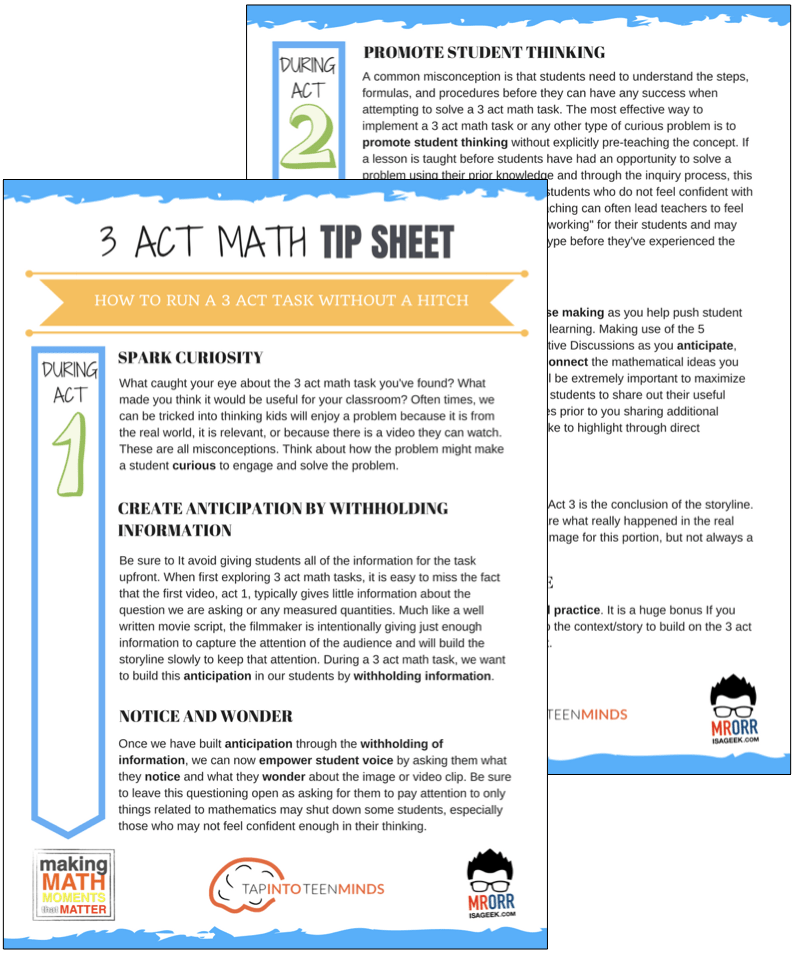
LESSONS TO MAKE MATH MOMENTS
Each lesson consists of:
Each Make Math Moments Problem Based Lesson consists of a Teacher Guide to lead you step-by-step through the planning process to ensure your lesson runs without a hitch!
Each Teacher Guide consists of:
- Intentionality of the lesson;
- A step-by-step walk through of each phase of the lesson;
- Visuals, animations, and videos unpacking big ideas, strategies, and models we intend to emerge during the lesson;
- Sample student approaches to assist in anticipating what your students might do;
- Resources and downloads including Keynote, Powerpoint, Media Files, and Teacher Guide printable PDF; and,
- Much more!
Each Make Math Moments Problem Based Lesson begins with a story, visual, video, or other method to Spark Curiosity through context.
Students will often Notice and Wonder before making an estimate to draw them in and invest in the problem.
After student voice has been heard and acknowledged, we will set students off on a Productive Struggle via a prompt related to the Spark context.
These prompts are given each lesson with the following conditions:
- No calculators are to be used; and,
- Students are to focus on how they can convince their math community that their solution is valid.
Students are left to engage in a productive struggle as the facilitator circulates to observe and engage in conversation as a means of assessing formatively.
The facilitator is instructed through the Teacher Guide on what specific strategies and models could be used to make connections and consolidate the learning from the lesson.
Often times, animations and walk through videos are provided in the Teacher Guide to assist with planning and delivering the consolidation.
A review image, video, or animation is provided as a conclusion to the task from the lesson.
While this might feel like a natural ending to the context students have been exploring, it is just the beginning as we look to leverage this context via extensions and additional lessons to dig deeper.
At the end of each lesson, consolidation prompts and/or extensions are crafted for students to purposefully practice and demonstrate their current understanding.
Facilitators are encouraged to collect these consolidation prompts as a means to engage in the assessment process and inform next moves for instruction.
In multi-day units of study, Math Talks are crafted to help build on the thinking from the previous day and build towards the next step in the developmental progression of the concept(s) we are exploring.
Each Math Talk is constructed as a string of related problems that build with intentionality to emerge specific big ideas, strategies, and mathematical models.
Make Math Moments Problem Based Lessons and Day 1 Teacher Guides are openly available for you to leverage and use with your students without becoming a Make Math Moments Academy Member.
Use our OPEN ACCESS multi-day problem based units!
Make Math Moments Problem Based Lessons and Day 1 Teacher Guides are openly available for you to leverage and use with your students without becoming a Make Math Moments Academy Member.
Partitive Division Resulting in a Fraction
Equivalence and Algebraic Substitution
Represent Categorical Data & Explore Mean
Downloadable resources including blackline masters, handouts, printable Tips Sheets, slide shows, and media files do require a Make Math Moments Academy Membership.
ONLINE WORKSHOP REGISTRATION

Pedagogically aligned for teachers of K through Grade 12 with content specific examples from Grades 3 through Grade 10.
In our self-paced, 12-week Online Workshop, you'll learn how to craft new and transform your current lessons to Spark Curiosity, Fuel Sense Making, and Ignite Your Teacher Moves to promote resilient problem solvers.
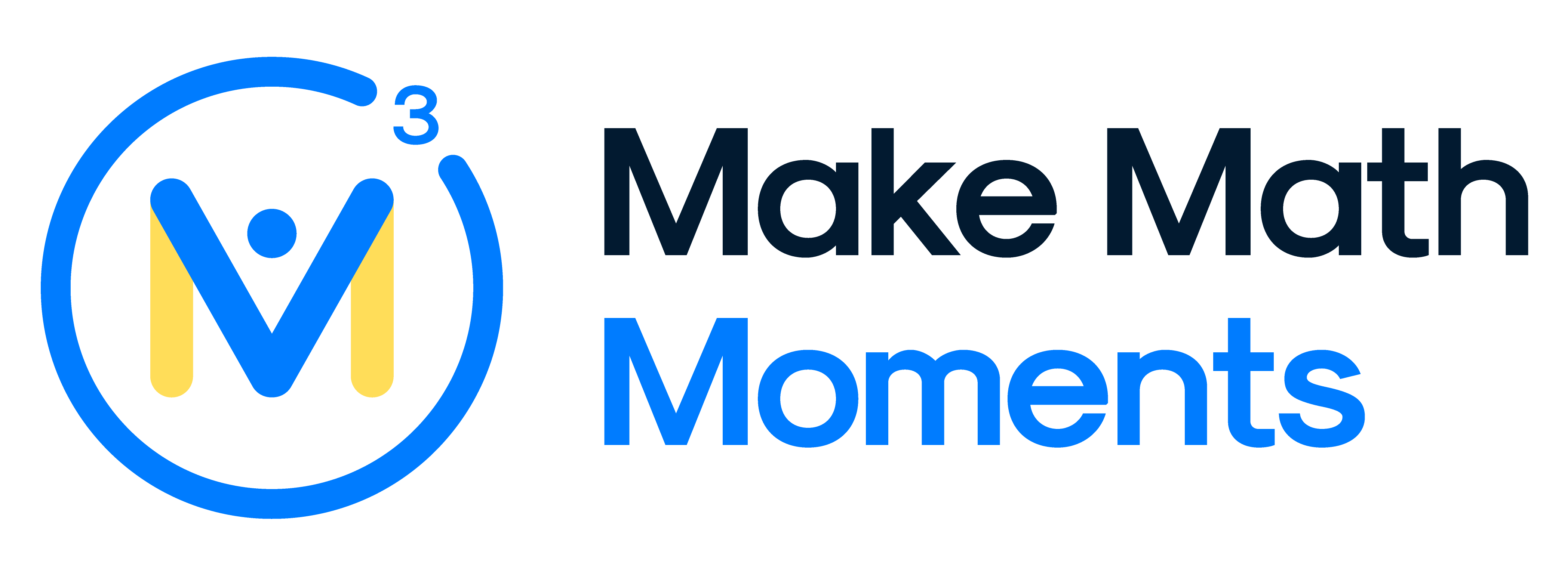



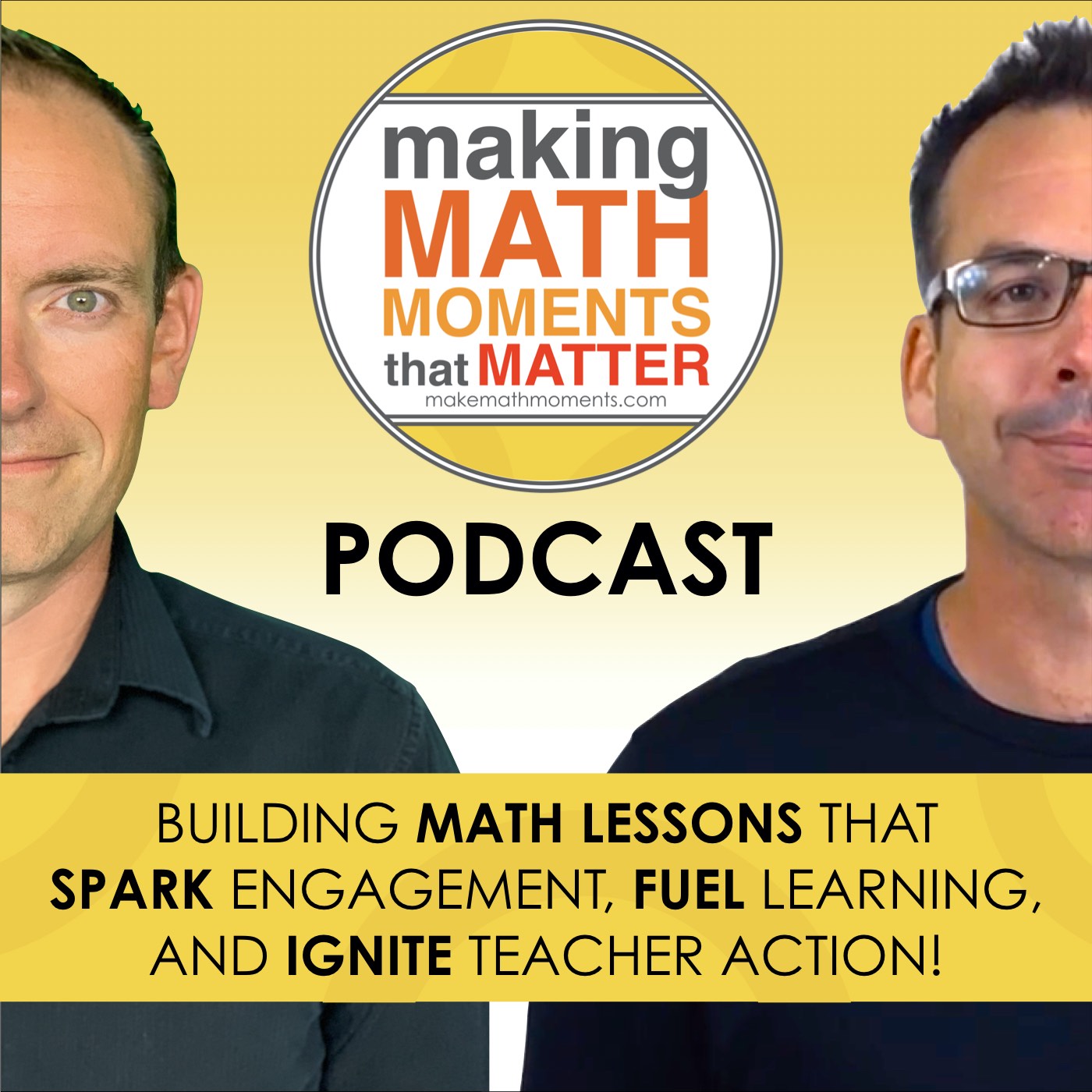


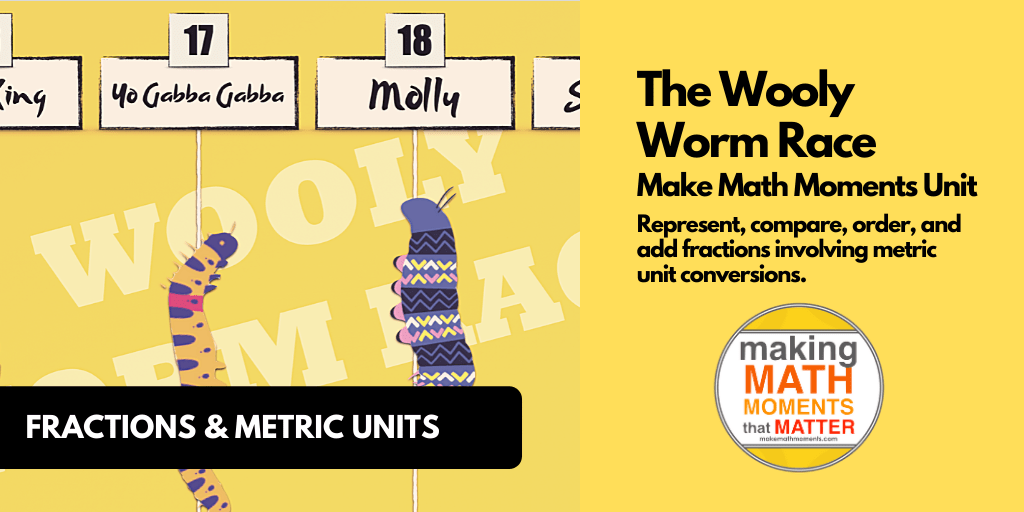
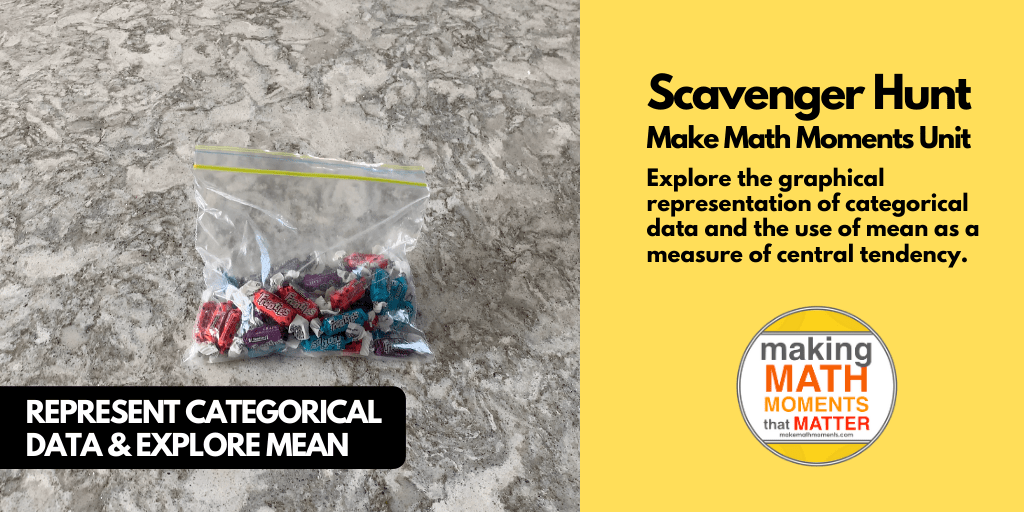

0 Comments